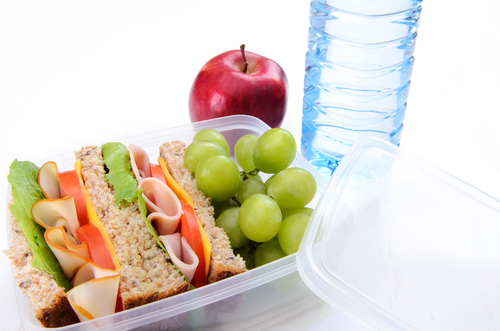Families across America are finishing summer vacations and summer BBQs, and returning to school schedules and more formal meals. This makes it a good time for some wellness training on safe food preparation. Today’s Advisor gives you valuable safety training content.

Thawing foods can present a food safety hazard if done improperly. There is a temperature danger zone in which food should not be stored for long. When thawing foods improperly, food can remain in this temperature danger zone for long periods and germs can multiply, which can lead to food poisoning.
Stored frozen food must, of course, be kept frozen. But when it’s time to thaw food, there are different methods you can use.
Here are some guidelines to proper thawing of frozen foods:
- The best way to thaw potentially hazardous foods is in the refrigerator, which will maintain food temperature at or below 41° Fahrenheit (F). Although this might take a few hours or even days, it’s the safest way to thaw frozen food. Be sure to place frozen food such as meat, poultry, and fish in a container that will catch juices as it thaws.
- You can also thaw frozen food by submerging it completely under running water as long as the water temperature is 70°F or 21° Celsius (C), or below. Other requirements include making sure the water is flowing sufficiently hard to float off loose particles in an overflow, keeping portions of ready-to-eat food at or below 41°F, and making sure raw meat doesn’t get above 41°F for more than 4 hours before being cooked.
- A quicker and easier method is to thaw food in the microwave. This is safe as long as the food is immediately transferred to conventional cooking equipment with no interruption in the cooking process.
- Never thaw any food at room temperature. After a short while, the outer portion of the food is in the danger zone and bacteria can start to grow while the inside of the food is still thawing.
Great news! BLR’s renowned Safety.BLR.com® website now has even more time-saving features. Take our no-cost site tour! Or better yet, try it at no cost or obligation for a full 2 weeks.
Cooking Temperature Guidelines
Food can look and smell good, but if it is not handled properly, germs can poison it and make consumers sick. Both at home and during commercial food preparation, following proper cooking procedures to ensure food is heated sufficiently to destroy germs is of paramount importance in food safety.
Here are some recommendations on safe cooking temperatures:
- Bacteria and other germs need time, food, and moisture to grow, but they can’t grow when the temperature of the food is colder than 45°F or 7°C, or hotter than 140° F or 60° C. Temperatures in between are in the danger zone. Keep foods out of the danger zone and you can prevent food-borne illness.
- Using a food thermometer to check temperatures to make sure foods are properly cooked is another way to help prevent food-borne illness. Place the thermometer in the thickest part of the meat or the center of the food to get a true reading.
- All poultry and stuffing must reach a temperature of 165°F or 74°C, or hotter, to destroy salmonella and other bacteria.
- Ground beef must be cooked to at least 155°F or 68°C. This includes hamburger for taco meat and meatloaf.
- Pork must be cooked to at least 150°F or 66°C to prevent trichinosis, a very serious illness caused by parasites.
- Rare beef can safely be cooked to only 130°F or 54°C, as long as it’s served right away.
- Beef, lamb, fish, and seafood must be cooked to 140°F or 60°C, or hotter, to kill bacteria.
Your one-stop safety management resource, available 24/7. Go here to take a no-cost site tour or here to try it in your own office!
When to Discard Food
When should you discard something to ensure that no one gets sick from contamination? Food can look and smell good, but if it is not handled properly, germs can poison it and make consumers sick. People can get sick if germs, viruses, pesticides, or cleaning agents get into food or drinks.
Here are some guidelines on when food should be discarded due to possible contamination:
- Food must be discarded if it has not been cooled or heated to the appropriate temperature within the time required for safety. If the freezer, refrigerator, or hot holding equipment fails and the temperature of the food is in the danger zone, then the food must also be discarded. (Between 45° and 140°F or 7° to 60°C is the danger zone in which foods are most likely to become contaminated by germs. Additionally, 165°F or 74°C is the minimum temperature to which food must be reheated.)
- Also dispose of food that is in a container or package that is not labeled or dated or if it is past the expiration date.
- Food should also be discarded if it has become unsafe or adulterated, such as if something unnecessary has been added. If should be discarded if you suspect that bacteria is growing in the food.
- Dispose of any ready-to-eat food that may have been contaminated by a sick employee. Also dispose of food that has been contaminated by employees, consumers, or others through contact with hands, sneezing, coughing, or other means.
The above information comes from BLR’s presentation “Food Service Safety.”
Why It Matters
- Food poisoning can be a serious situation requiring hospitalization and, of course, time away from work.
- Wellness training that helps employees keep themselves and their family members protected from food poisoning can keep them healthy and on the job.
- Such training can be formal or informal, such as including a food safety story in the company newsletter or intranet posting area.
